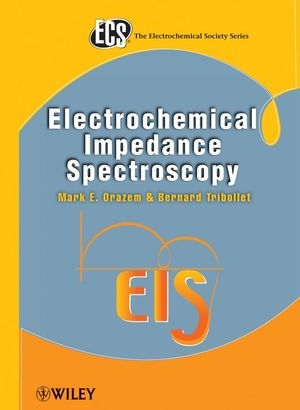
Electrochemical Impedance Spectroscopy
Wiley-Blackwell (Verlag)
978-0-470-04140-6 (ISBN)
- Titel ist leider vergriffen;
keine Neuauflage - Artikel merken
Using electrochemical impedance spectroscopy in a broad range of applications This book provides the background and training suitable for application of impedance spectroscopy to varied applications, such as corrosion, biomedical devices, semiconductors and solid-state devices, sensors, batteries, fuel cells, electrochemical capacitors, dielectric measurements, coatings, electrochromic materials, analytical chemistry, and imaging. The emphasis is on generally applicable fundamentals rather than on detailed treatment of applications.
With numerous illustrative examples showing how these principles are applied to common impedance problems, Electrochemical Impedance Spectroscopy is ideal either for course study or for independent self-study, covering: Essential background, including complex variables, differential equations, statistics, electrical circuits, electrochemistry, and instrumentation Experimental techniques, including methods used to measure impedance and other transfer functions Process models, demonstrating how deterministic models of impedance response can be developed from physical and kinetic descriptions Interpretation strategies, describing methods of interpretating of impedance data, ranging from graphical methods to complex nonlinear regression Error structure, providing a conceptual understanding of stochastic, bias, and fitting errors in frequency-domain measurements An overview that provides a philosophy for electrochemical impedance spectroscopy that integrates experimental observation, model development, and error analysis This is an excellent textbook for graduate students in electrochemistry, materials science, and chemical engineering.
It's also a great self-study guide and reference for scientists and engineers who work with electrochemistry, corrosion, and electrochemical technology, including those in the biomedical field, and for users and vendors of impedance-measuring instrumentation.
MARK E. ORAZEM is a Professor in the Department of Chemical Engineering at the University of Florida. He organized the 6th International Symposium on Electrochemical Impedance Spectroscopy and teaches a short course on impedance spectroscopy for The Electrochemical Society. Dr. Orazem is a Fellow of The Electrochemical Society (ECS) and a member of the International Society of Electrochemistry (ISE). BERNARD TRIBOLLET is a Director of Research at the Centre National de la Recherche Scientifique (CNRS) and Associate Director of the Laboratoire Interfaces et Systemes Electrochimique at Pierre and Marie Curie University. He instructs an annual short course on impedance spectroscopy. Dr. Tribollet is a member of The Electrochemical Society (ECS) and the International Society of Electrochemistry (ISE).
Preface. Acknowledgments. The Blind Men and the Elephant. History of Impedance Spectroscopy. I: Background. 1. Complex Variables. 1.1 Why Imaginary Numbers? 1.2 Terminology. 1.3 Operations Involving Complex variables. 1.4 Elementary Functions of Complex Variables. Problems. 2. Differential Equations. 2.1 Linear First-Order Differential Equations. 2.2 Homogeneous Linear Second-Order Differential Equations. 2.3 Nonhomogeneous Linear Second-Order Differential Equations. 2.4 Partial Differential Equations by Similarity Transformations. 2.5 Differential Equations with Complex Variables. Problems. 3. Statistics. 3.1 Definitions. 3.2 Error Propagation. 3.3 Hypothesis Tests. Problems. 4. Electrical Circuits. 4.1 Passive Electrical Circuits. 4.2 Fundamental Relationships. 4.3 Nested Circuits. 4.4 Mathematical Equivalence of Circuits. 4.5 Graphical Representation of Circuit Response. Problems. 5. Electrochemistry. 5.1 Resistors and Electrochemical Cells. 5.2 Equilibrium in Electrochemical Systems. 5.3 Polarization Behavior for Electrochemical Systems. 5.4 Definitions of Potential. 5.5 Rate Expressions. 5.6 Transport Processes. 5.7 Potential Contributions. 5.8 Capacitance Contributions. Problems. 6. Electrochemical Instrumentation. 6.1 The Ideal Operational Amplifier. 6.2 Elements of Electrochemical Instrumentation. 6.3 Electrochemical Interface. Problems. II: Experimental Considerations. 7. Experimental Methods. 7.1 Steady-State Polarization Curves. 7.2 Transient Response to a Potential Step. 7.3 Analysis in Frequency Domain. 7.4 Comparison of Measurement Techniques. 7.5 Specialized Techniques. Problems. 8. Experimental Design. 8.1 Cell Design. 8.2 Experimental Considerations. 8.3 Instrumentation Parameters. Problems. III: Process Models. 9. Equivalent Circuit Analogs. 9.1 General Approach. 9.2 Current Addition. 9.3 Potential Addition. Problems. 10. Kinetic Models. 10.1 Electrochemical Reactions. 10.2 Reaction Dependent on Potential Only. 10.3 Reaction Dependent on Potential and Mass Transfer. 10.4 Coupled Reactions Dependent on Potential and Surface Coverage. 10.5 Reactions Dependent on Potential, Surface Coverage, and Transport. Problems. 11. Diffusion Impedance. 11.1 Uniformly Accessible Electrode. 11.2 General mathematical Framework. 11.3 Stagnant Diffusion Layer. 11.4 Diffusion through a Solid Film. 11.5 Coupled Diffusion Impendence. 11.6 Rotating Disk. 11.7 Submerged Impinging Jet. 11.8 Rotating Cylinders. Problems. 12. Semiconducting Systems. 12.1 Semiconductor Physics. 12.2 Steady-State Models. 12.3 Impedance Models. Problems. 13. Time-Constant Dispersion. 13.1 Constant-Phase Elements. 13.2 Convective Diffusion Impedance at Small Electrodes. 13.3 Geometry-Induced Current and Potential Distributions. 13.4 Porous Electrodes. 13.5 Oxide Layers. Problems 14. Generalized Transfer Functions. 14.1 Multi-Input/Multi-Output Systems. 14.2 Transfer Functions Involving Exclusively Electrical Quantities. 14.3 Transfer Functions Involving Nonelectrical Quantities. Problems. 15. Electrohydrodynamic Impedance. 15.1 Hydrodynamic Transfer Function. 15.2 Mass-Transport Transfer Function. 15.3 Kinetic Transfer Function for Simple Electrochemical Reactions. 15.4 Interface with a 2-D or 3-D Insulating Phase. Problems. IV: Interpretation Strategies. 16. Methods for Representing Impedance. 16.1 Impedance Format. 16.2 Admittance Format. 16.3 Complex-Capacitance Format. 16.4 Effective Capacitance. Problems. 17. Preliminary Graphical Methods. 17.1 Application to a Randles Circuit. 17.2 Application to Blocking Electrodes. 17.3 Overview. Problems. 18. Model-Based Graphical Methods. 18.1 Mass Transfer. 18.2 Reaction Kinetics: Arrhenius Relations. 18.3 Mott-Schottky Plots. Problems. 19. Complex Nonlinear Regression. 19.1 Concept. 19.2 Objective Functions. 19.3 Formalism of Regression Strategies. 19.4 Regression Strategies for Nonlinear Problems. 19.5 Influence of Data Quality on Regression. 19.6 Initial Estimates for regression. 19.7 Regression Statistics. Problems. 20. Assessing regression Quality. 20.1 Methods to Assess Regression Quality. 20.2 Application of Regression Concepts. V: Statistical Analysis. 21. Error Structure of Impedance Measurements. 21.1 Error Contributions. 21.2 Stochastic Errors in Impedance measurements. 21.3 Bias Errors. 21.4 Incorporation of Error Structure. 21.5 Measurement Models for Error Identification. 22. The Kramers-Kronig Relations. 22.1 mathematical Origin. 22.2 The Kramers-Kronig in an Expectation Sense. 22.3 Methods for Application. Problems. VI: Overview. 23. An Integrated Approach to Impedance Spectroscopy. 23.1 Flowcharts for Regression Analysis. 23.2 Integration of Measurements, Error Analysis, and Model. 23.3 Application. Problems. VII: Reference Material. A. Complex Integrals. B. Tables of Reference Material. C. List of Examples. List of Symbols. References. Index.
| Reihe/Serie | Electrochemical Society Series |
|---|---|
| Verlagsort | Hoboken |
| Sprache | englisch |
| Maße | 188 x 262 mm |
| Gewicht | 1 g |
| Themenwelt | Naturwissenschaften ► Chemie ► Analytische Chemie |
| Naturwissenschaften ► Chemie ► Physikalische Chemie | |
| ISBN-10 | 0-470-04140-4 / 0470041404 |
| ISBN-13 | 978-0-470-04140-6 / 9780470041406 |
| Zustand | Neuware |
| Informationen gemäß Produktsicherheitsverordnung (GPSR) | |
| Haben Sie eine Frage zum Produkt? |
aus dem Bereich



